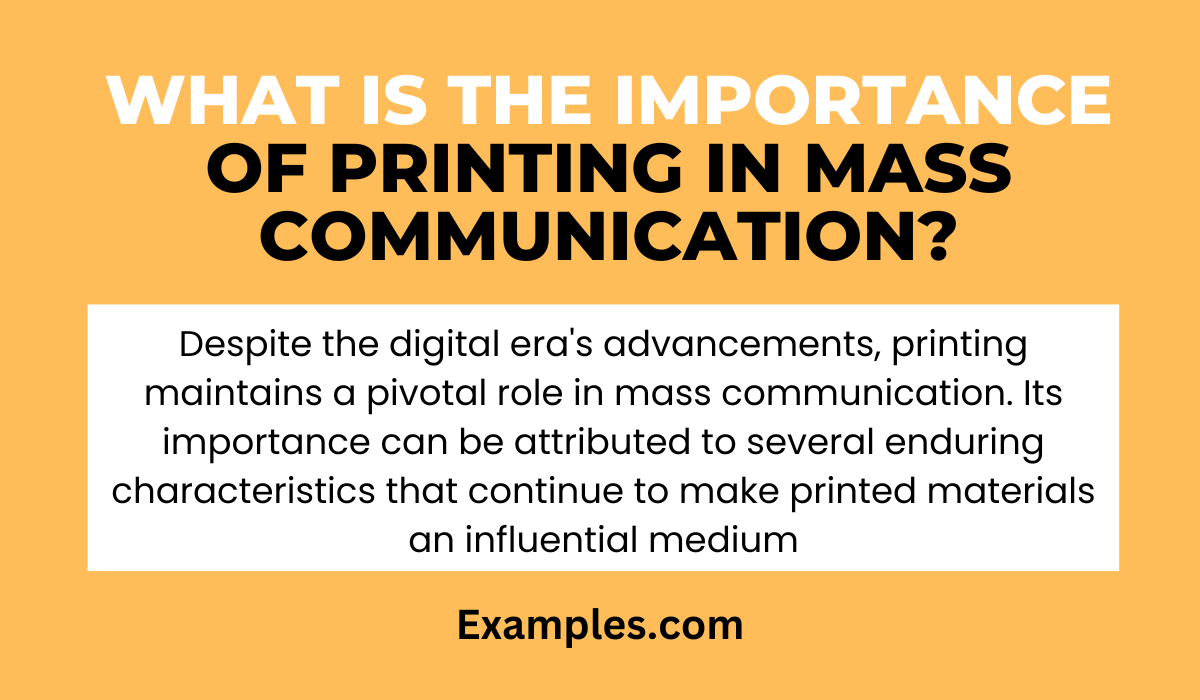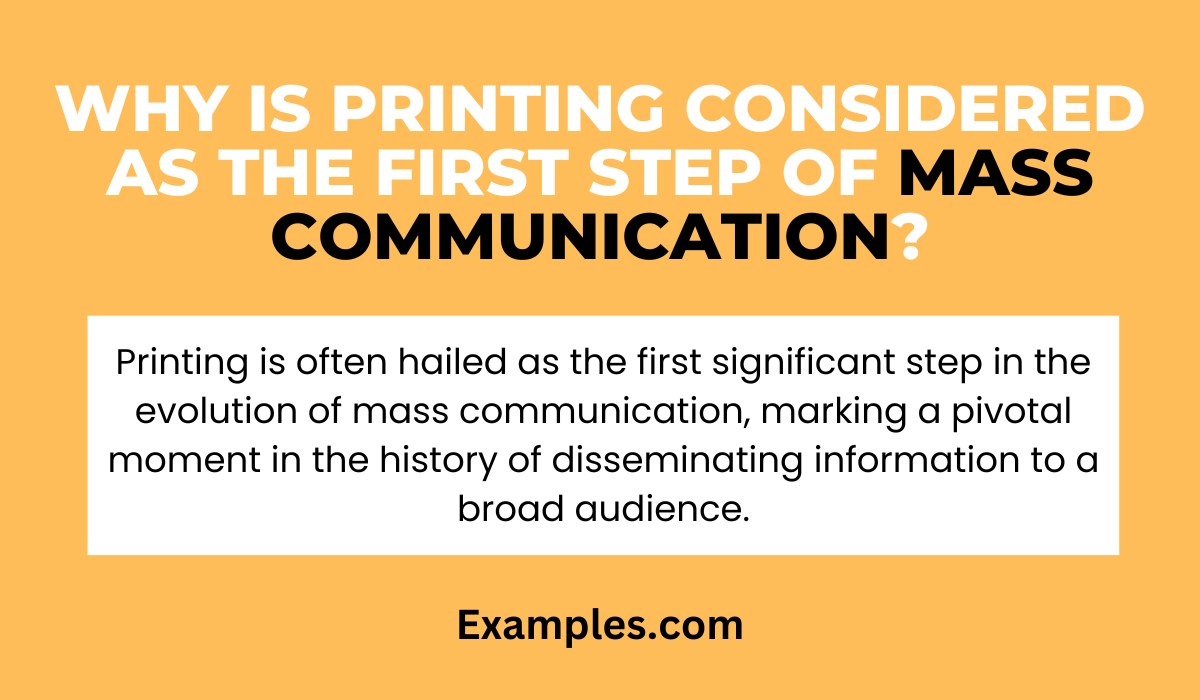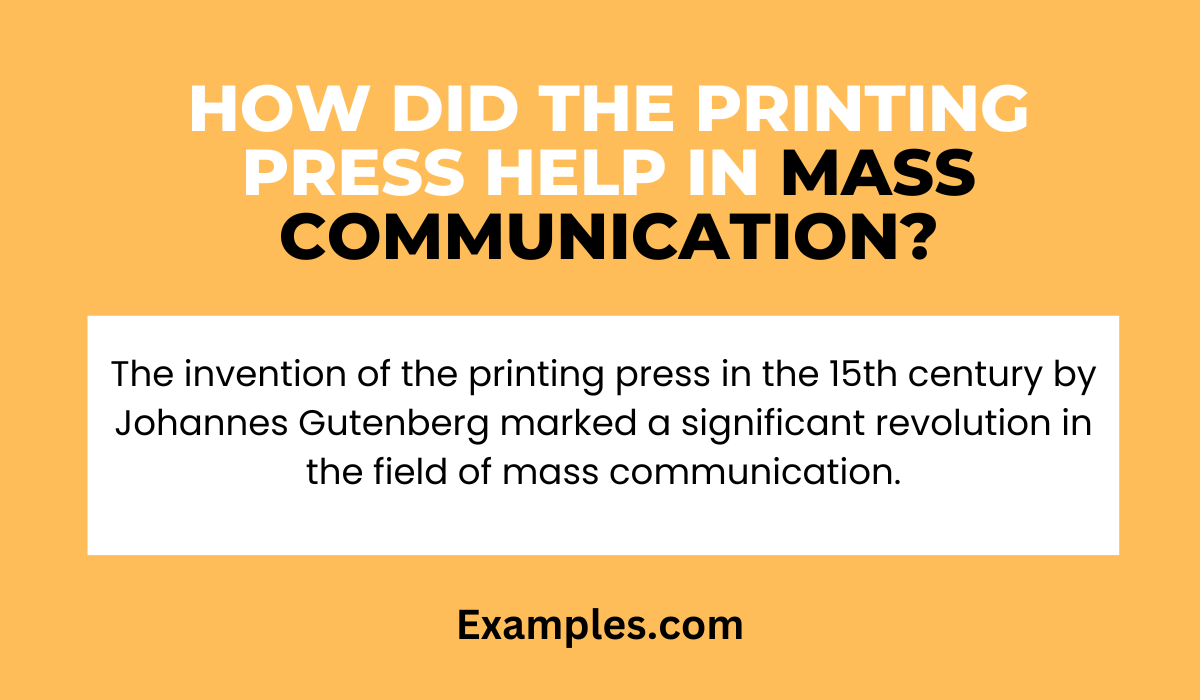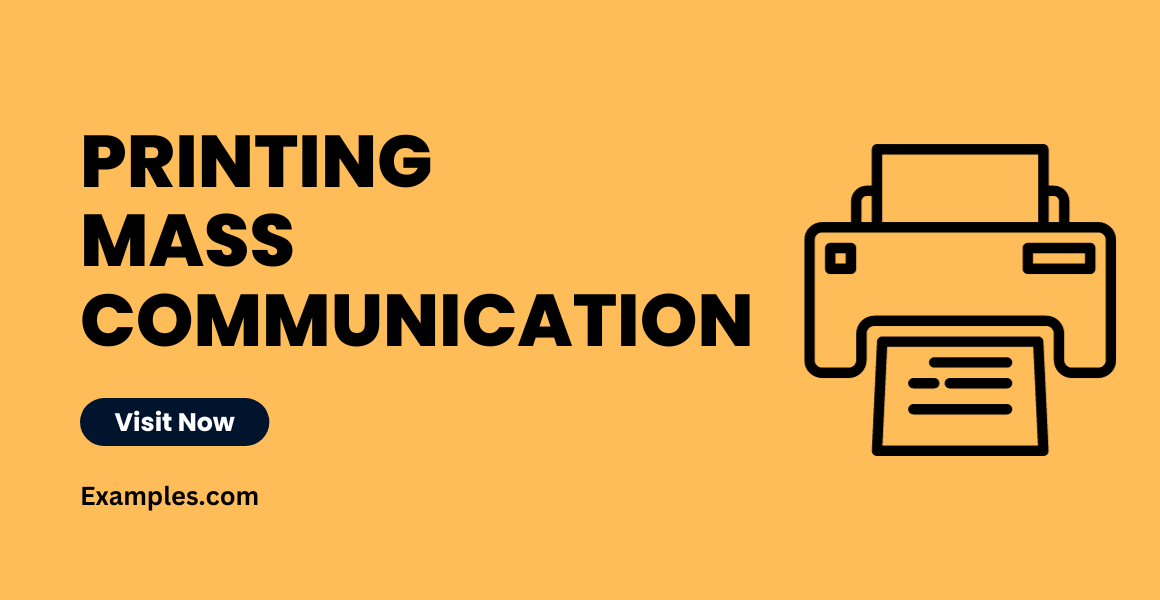Printing Mass Communication Examples
Printing in mass communication remains a powerful and influential medium, despite the digital age. This guide delves into the enduring significance of printed materials in disseminating information and shaping public opinion. From newspapers and magazines to flyers and brochures, printing offers tangible and diverse communication examples that connect with audiences in unique ways. We explore various printing techniques and their applications in mass communication, highlighting how this traditional form of media continues to play a crucial role in information dissemination and cultural expression.
What is Printing in Mass Communication?
Printing in mass communication refers to the process of distributing information and ideas to a wide audience through printed materials. This traditional form of communication utilizes physical media like newspapers, magazines, brochures, and books to convey messages to the public. It plays a crucial role in educating, informing, and entertaining people, making it an essential component of the mass media landscape. Despite the rise of digital media, printing continues to hold a significant place in public discourse and media consumption, offering a tangible and often more permanent way to access information and knowledge.
What is the Importance of Printing in Mass Communication?
Despite the digital era’s advancements, printing maintains a pivotal role in mass communication. Its importance can be attributed to several enduring characteristics that continue to make printed materials an influential medium in the dissemination of information.

Tangibility and Permanence
- Physical Presence: Printed materials offer a tangible form of communication that people can physically hold, enhancing the sensory experience of receiving information.
- Longevity: Unlike digital content that can be transient, printed materials have a lasting presence, often preserved for future reference.
Credibility and Trust
- Perceived Authenticity: There is a longstanding perception that printed information, such as newspapers and academic journals, carries more authenticity and credibility.
- Trustworthiness: Many people continue to trust printed materials over digital sources due to concerns about misinformation online.
Wide Accessibility
- No Digital Divide: Printed media is accessible to all, including those without internet access, ensuring information reaches a broader audience.
- Ease of Distribution: Newspapers and flyers can be distributed in public spaces, reaching people in their everyday lives.
Targeted Communication
- Niche Audiences: Specialized magazines and brochures cater to specific interests, effectively reaching targeted demographic groups.
- Localized Content: Local newspapers and bulletins provide community-specific content, essential for regional engagement.
Complementing Digital Media
- Multi-Channel Strategies: Print often works in conjunction with digital media, offering a multi-faceted approach to mass communication.
- Enhanced Marketing: In advertising, print materials supplement online campaigns, increasing the overall impact.
Visual Impact and Design
- Aesthetic Appeal: High-quality printing allows for creative designs and impactful visuals, which can be more striking in a physical format.
- Brand Identity: For businesses, printed materials like brochures and business cards are crucial for establishing brand identity.
Educational Tool
- Learning Resource: Textbooks and educational materials in print form are fundamental tools in teaching and learning.
- Focus and Comprehension: Studies suggest that reading in print can aid in better focus and comprehension compared to digital reading.
The importance of printing in mass communication lies in its unique ability to provide tangible, credible, and accessible content. It complements digital media and continues to be an effective tool for targeted and impactful communication. The integration of print and digital strategies ensures a comprehensive approach to reaching and engaging diverse audiences in today’s media landscape.
Why is Printing Considered as the First Step of Mass Communication?
Printing is often hailed as the first significant step in the evolution of mass communication, marking a pivotal moment in the history of disseminating information to a broad audience. Its inception and development laid the groundwork for modern mass communication, revolutionizing how information was shared and consumed.

Historical Significance
- Invention of the Printing Press: The introduction of the printing press by Johannes Gutenberg in the 15th century was a landmark event. It enabled the mass production of books and written materials, democratizing access to knowledge.
- Widespread Literacy: Printing played a crucial role in increasing literacy rates. As printed materials became more accessible, more people learned to read, widening the audience for written content.
Foundation for Modern Media
- Standardization of Information: Printing allowed for the standardization and preservation of information. This consistency was essential for the development of reliable and structured communication.
- Blueprint for Future Media: The principles of printing, including content creation, editing, and distribution, became the blueprint for subsequent forms of mass communication like newspapers, radio, and television.
Cultural and Societal Impact
- Spread of Ideas and Knowledge: Printing facilitated the spread of new ideas, scientific knowledge, and cultural values across different societies, influencing the Renaissance and the Enlightenment periods.
- Foundation of Journalism: The printing press led to the birth of newspapers and periodicals, laying the foundation for journalism as a profession and an essential element of mass communication.
Economic and Political Influence
- Commercialization of Information: Printing introduced the concept of commercializing information, leading to the development of the publishing industry and advertising.
- Political Mobilization: Printed materials such as pamphlets and flyers played a significant role in political movements, enabling leaders to mobilize public opinion more effectively.
Printing, in essence, is not just a technological innovation; it represents a fundamental shift in the way humans communicate, share knowledge, and engage in societal discourse. It set in motion the practices and concepts that would define mass communication in the centuries to follow, earning its place as the first critical step in the evolution of mass media.
How Did the Printing Press Help in Mass Communication?
The invention of the printing press in the 15th century by Johannes Gutenberg marked a significant revolution in the field of mass communication. Its impact on the dissemination of information and the shaping of public opinion has been profound and enduring.

Here’s how the printing press played a crucial role in the development of mass communication:
Democratization of Information
- Widespread Information Access: Before the printing press, information was limited to manuscripts hand-copied by a few. The printing press allowed for the mass production of books and documents, making information accessible to a wider audience.
- Increased Literacy Rates: As printed materials became more available, literacy rates increased, allowing more people to access and consume information.
Standardization of Texts
- Uniformity in Communication: The printing press enabled the production of standardized texts. This uniformity ensured that information was consistent and reliable across different printed materials.
- Preservation of Knowledge: Printed materials could be replicated accurately, preserving knowledge and information over time.
Influence on Public Opinion and Society
- Spread of Ideas: The printing press facilitated the spread of new ideas and thoughts, contributing to significant social and cultural changes, including the Renaissance and the Reformation.
- Formation of Public Opinion: Printed materials like pamphlets and newspapers became tools for shaping public opinion, influencing societal and political matters.
Impact on Education and Science
- Educational Advancement: The availability of textbooks and educational materials revolutionized learning and academic research.
- Scientific Communication: Scientists could share their discoveries more widely and efficiently, leading to an acceleration in scientific progress.
Economic and Commercial Growth
- Commercial Publishing: The printing press gave rise to the publishing industry, creating new economic opportunities and markets.
- Advertising and Promotion: Printed materials became a means for commercial advertising and promotion, influencing consumer behavior.
Foundation for Modern Media
- Precursor to Modern Journalism: The printing press laid the groundwork for the development of newspapers and magazines, leading to the rise of modern journalism.
- Evolution into Digital Printing: The principles of the printing press have evolved into digital printing technologies, further advancing mass communication in the digital age.
The printing press was a pivotal invention in the history of mass communication, catalyzing the spread of knowledge, ideas, and cultural exchange. Its contributions to society, education, and the media landscape have been foundational, setting the stage for the diverse and interconnected world of modern communication.
How to Use Printing in Mass Communication?
Using printing in mass communication involves understanding its strengths and effectively integrating it into a broader communication strategy. Despite the dominance of digital media, printing still has a significant impact due to its physical nature and accessibility. Here’s how to effectively utilize printing in the realm of mass communication.
Identifying the Target Audience
- Audience Analysis: Determine the demographics, interests, and preferences of the intended audience. This helps in tailoring the content and design of printed materials.
- Localized Reach: Use printing for reaching local audiences, as it can be highly effective in community-focused campaigns.
Choosing the Right Material
- Selecting Appropriate Formats: Depending on the message and audience, choose from various formats like newspapers, magazines, brochures, flyers, or posters.
- Quality and Sustainability: Consider the quality of paper and printing materials, keeping in mind sustainability and environmental impact.
Designing for Impact
- Engaging Design: Employ compelling designs that grab attention. Utilize graphics, colors, and typography effectively.
- Clear and Concise Messaging: Ensure that the printed material communicates the message clearly and concisely, making it easy for the audience to understand and remember.
Integrating with Digital Media
- Cross-Media Campaigns: Combine printing with digital media campaigns for a broader reach. For example, include social media handles or QR codes in printed materials.
- Consistency Across Platforms: Maintain consistency in messaging and branding across both printed and digital platforms.
Distribution Strategies
- Strategic Placement: Distribute printed materials in locations frequented by the target audience, such as community centers, educational institutions, or shopping areas.
- Event Distribution: Utilize events, conferences, and public gatherings for the distribution of printed materials.
Measuring Effectiveness
- Feedback Mechanisms: Include ways to track engagement, such as contact information, QR codes, or social media links.
- Analyzing Response: Monitor and analyze the response to the printed materials to gauge their effectiveness and impact.
Staying Informed and Adapting
- Market Trends: Stay informed about the latest trends in printing technology and design to keep the materials relevant and engaging.
- Adapting to Change: Be ready to adapt strategies based on audience feedback and changing market conditions.
Incorporating printing into mass communication strategies requires thoughtful planning, creative design, and strategic distribution. By understanding its unique advantages and combining it effectively with digital strategies, printing can significantly enhance the reach and effectiveness of mass communication campaigns.
In conclusion, printing in mass communication continues to be a vital tool, complementing the digital landscape with its tangible and impactful presence. Emphasizing targeted outreach and creative design, printed materials effectively bridge the gap between traditional and modern communication methods. Their enduring relevance in disseminating information underscores the power of combining classic techniques with contemporary strategies in the ever-evolving world of media communication.



